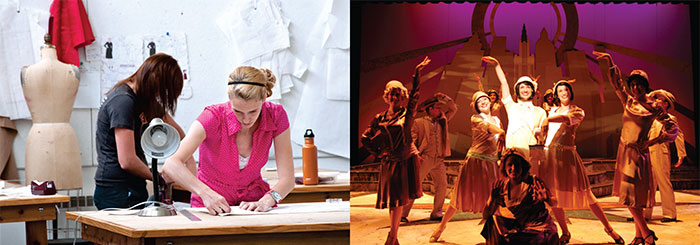A New Vision

Change is nothing new for Columbia’s oldest academic institution. Since its founding in 1833 as the Columbia Female Academy, the college has gone under a few names, finally becoming Stephens College in 1870. Nearly 150 years later, Stephens College is again going through some big changes; this time they come in the form of new academic schools.
The new schools and their respective deans are the School of Organizational Leadership and Strategic Communication, Dean Susan Bartel; the School of Humanities and Sciences, Dean Tara Giblin; and the School of Interdisciplinary Studies, Dean Leslie Willey. They join Dean Beth Leonard of the School of Performing Arts, established in 2005, and Dean Monica McMurry of the School of Fashion and Design, established in 2006 as the School of Design and Fashion.
Change in reorganization
The reorganization into five schools is expected to be cost neutral, and Bartel says she feels savings might be possible in the future. “As we work together, we’ll find better ways to combine resources,” she says.
Students should notice little change from the reorganization. “For example, instead of going to the psychology department chair about a concern, they’d come to me,” says Giblin, who had just returned from a yearlong Fulbright fellowship in Nepal when she learned about the restructuring. “Otherwise, I don’t think students will notice.”
But the idea of creating smaller academic schools was years in the making.

“It’s important to understand the process was started by Rex Stevens when he was vice president for academic affairs under former President Wendy Libby,” says current Stephens College President Diane Lynch, who has been at Stephens since June 2009.
Lynch says with the two schools established, it was natural to create the other schools to make faculty representation and organization more clear and consistent.
“Before there was a wide array of organizational units,” Lynch says. “You had deans from the two schools but also department chairs and program directors. There were too many inconsistencies of faculty representation and different levels of review.”
Before the restructuring, when all the schools, departments and programs got together, there were 13 people who represented vastly different groups. “Some represented only themselves; others represented an entire school,” Lynch says.
Planning to restructure
The process started when Nancy Cornwell, interim vice president of academic affairs, met with the department chairs to discuss possibilities of academic restructuring. From this came about a dozen proposals that went on to the board of trustees. Senior staff, faculty and students were also invited to discuss the restructuring and provide their input, but it was Lynch’s call.
Bartel, who has been at Stephens for seven years, arrived right when the first two schools were created.
“At that time the ultimate goal was to reorganize all departments into schools,” Bartel says. “For a variety of reasons, the restructure didn’t happen. When Diane came on board, she saw the need and took action.”

Lynch decided to go with a plan that continued with the two existing schools and their deans while promoting three senior faculty members to head the three newly created schools.
“For me, we’ve created a stable, clear, consistent structure that will support the growth of our academic programs,“ Lynch says. “We used to talk about big programs and little programs. Now all the programs are much closer in size.”
Giblin agrees. “Programs such as natural science, English, psychology and business were representing themselves,” she says.
Now each school has about 10 to 15 faculty members. One of the newly created schools, the School of Interdisciplinary Studies contains a wide array of programs, including everything from digital filmmaking to equestrian science. But due to the diverse nature of the programs, Lynch says the relatively unique collection is a great fit and will succeed due to great leadership.
“We have a really strong team of academic leaders,” Lynch says. “I came out of the dean’s retreat this summer more excited about the academic programs than I’ve ever been.”
Time in the classroom
Transferring leadership to five deans instead of 14 department heads also allows for professors to spend less time doing administrative work and more time teaching in the classroom.
“We’re a teaching institution,” Bartel says. “We have stellar faculty. We need them in the classroom, not stuck in the office, not doing paperwork. They came to teach.”
The administration is looking forward to the different ways the new schools will generate partnerships and creative ideas.
“For me I’m just really excited about the opportunity for new perspectives of what faculty members do,” Giblin says. “It gives us a chance to shake things up. Different points of view coming together bring new, fresh ideas. I’ve already started to appreciate work that I didn’t realize they were doing in English, art, etc.”
Students will not see any changes in their faculty, courses or major. No academic programs or faculty positions are being eliminated. However, with more full-time faculty returning to the classroom, there will be changes to the number of adjunct professors.
Lynch says the new schools give students an even greater sense of belonging. They now have more of an academic home. “Before, I’d hear the occasional student say, ‘Why don’t I have a dean?’” she says. “Now they have a dean to go talk to.”
Lynch, who was previously in administrative roles and dean of the Roy H. Park School of Communications at Ithaca College in Ithaca, N.Y., and chair of the Department of Journalism at Saint Michael’s College in Burlington, Vt., has been part of reorganization at the program level but hadn’t worked at an institution where the entire academic structure was revamped. Lynch says the transition will go smoothly thanks, in part, to Stephens’ size.
“One of the great strengths is its size because it is so nimble,” she says. “We are responsive to the needs of our students.”
Bartel is optimistic about the restructuring. “Up to this point, I can’t see a downside,” she says. “But the real test will be how the students feel at the end of the semester.”
But even with the restructuring, some things will never change. “Students on campus have strong relationships with faculty in their programs,” Willey, a Stephens alumna, says. “That will always stay the same.”


